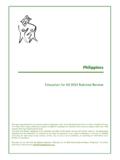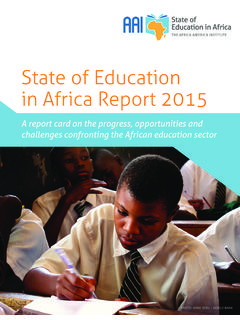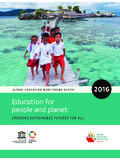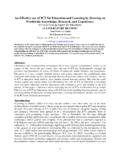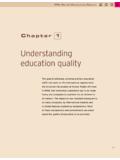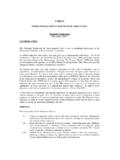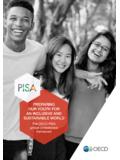Transcription of INSTITUTE FOR STATISTICS Literacy Skills for the …
1 INSTITUTE FOR STATISTICSUNESCOINSTITUTEforSTATISTICS[] Executive SummaryLiteracy Skills for the world of tomorrow FURTHER RESULTS fromPISA 2000 ORGANISATION forECONOMIC CO-OPERATION andDEVELOPMENTLITERACY Skills FOR THE world OF tomorrow FURTHER RESULTS FROM PISA 2000 EXECUTIVE SUMMARYORGANISATION FOR ECONOMIC CO-OPERATION AND DEVELOPMENTUNESCO INSTITUTE FOR STATISTICS2 Organisation for Economic Co-operation and DevelopmentPursuant to Article 1 of the Convention signed in Paris on December 14, 1960, and which came into force onSeptember 30, 1961, the Organisation for Economic Co-operation and Development (OECD) shall promote policiesdesigned to: achieve the highest sustainable economic growth and employment and a rising standard of living in Membercountries, while maintaining financial stability, and thus to contribute to the development of the world economy; contribute to sound economic expansion in Member as well as non-member countries in the process of economicdevelopment; and contribute to the expansion of world trade on a multilateral, non-discriminatory basis in accordance withinternational original Member countries of the OECD are Austria, Belgium, Canada, Denmark, France, Germany, Greece,Iceland, Ireland, Italy, Luxembourg, the Netherlands, Norway, Portugal, Spain, Sweden, Switzerland, Turkey, theUnited Kingdom and the United States.
2 The following countries became Members subsequently through accession atthe dates indicated hereafter: Japan (April 28, 1964), Finland (January 28, 1969), Australia (June 7, 1971), NewZealand (May 29, 1973), Mexico (May 18, 1994), the Czech Republic (December 21, 1995), Hungary (May 7, 1996),Poland (November 22, 1996), Korea (December 12, 1996) and the Slovak Republic (December 14, 2000). TheCommission of the European Communities takes part in the work of the OECD (Article 13 of the OECDC onvention).UNESCOThe constitution of the United Nations Educational, Scientific and Cultural Organization ( unesco ) was adopted by20 countries at the London Conference in November 1945 and entered into effect on November 4, 1946. TheOrganization currently has 188 Member main objective of unesco is to contribute to peace and security in the world by promoting collaboration amongnations through education, science, culture and communication in order to foster universal respect for justice, the ruleof law, and the human rights and fundamental freedoms that are affirmed for the peoples of the world , withoutdistinction of race, sex, language or religion, by the Charter of the United fulfill its mandate, unesco performs five principal functions: 1) prospective studies on education, science, cultureand communication for tomorrow s world ; 2) the advancement, transfer and sharing of knowledge through research,training and teaching activities; 3) standard-setting actions for the preparation and adoption of internal instrumentsand statutory recommendations.
3 4) expertise through technical co-operation to Member States for their developmentpolicies and projects; and 5) the exchange of specialized is headquartered in Paris, unesco INSTITUTE for StatisticsThe unesco INSTITUTE for STATISTICS (UIS) is the statistical office of unesco and is the UN depository for globalstatistics in the fields of education, science and technology, culture and was established in 1999. It was created to improve unesco s statistical programme and to develop and deliverthe timely, accurate and policy-relevant STATISTICS needed in today s increasingly complex and rapidly changing social,political and economic is based in Montr al, credit: OECD/ unesco -UIS 2003 Permission to reproduce a portion of this work for non-commercial purposes or classroom use should be obtainedthrough the Centre fran ais d exploitation du droit de copie(CFC), 20, rue des Grands-Augustins, 75006 Paris, France,tel.
4 (33-1) 44 07 47 70, fax (33-1) 46 34 67 19, for every country except the United States. In the United States,permission should be obtained through the Copyright Clearance Center, Customer Service, (508) 750-8400,222 Rosewood Drive, Danvers, MA 01923, USA, or CCC Online ( ). All other applications forpermission to reproduce or translate all or part of this book should be made to OECD Publications, 2, rue Andr -Pascal, 75775 Paris Cedex 16, France or unesco Publishing, Editorial and Rights Division, 7, place de Fontenoy,75352 Paris 07 SP or 1, rue Miollis, 75732 Paris Cedex 15, France. Fax: (33-1) 45 68 57 39. Tel. (33-1) 45 68 49 designations employed and the presentation of material throughout this publication do not imply the expression of any opinionwhatsoever on the part of unesco and OECD concerning the legal status of any country, territory, city or area or of its authorities,or the delimitation of its frontiers or Skills for the world of tomorrow Further results from PISA 2000 Executive SummaryThe Programme for International Student Assessment (PISA) is a collaborativeeffort among the participating countries to measure how well 15-year-olds,approaching the end of compulsory schooling, are prepared to meet thechallenges of today s societies.
5 PISA administers tests and backgroundquestionnaires to between 4,500 and 10,000 students in each participatingcountry to assess three forms of Literacy : reading, mathematical and assessments focus on how well students apply knowledge and Skills to tasksthat are relevant to their future life, rather than on the memorisation of subjectmatter assessment was first administered in 2000 in 32 countries, all but four ofthem members of the Organisation for Economic Co-operation andDevelopment (OECD) (See Figure 1). In response to considerable worldwideinterest in the study, the assessment was extended in 2001 to 11 additional non-OECD countries, bringing the total number of countries surveyed to 43. Theresults for the first 32 countries were reported in Knowledge and Skills for Lifepublished in Skills for the world of Tomorrowexpands on this analysiswith particular reference to the results in the 15 non-OECD provides important information on factors associated with students Literacy proficiency, including student engagement in the learning process,gender and family background, and offers insights into how characteristics ofschools, such as the organisation of learning and the availability andmanagement of resources, are associated with educational the programme is administered once every three years, it offers policy-makers a lens through which to monitor student outcomes over time and toassess the strengths and weaknesses of their own systems in the light of othercountries PISA and related work.
6 OECD and unesco seek to contribute to a shift in policy focus from educational inputs to learningoutcomes, in order to assist countries in seeking to bring about improvementsin schooling and better preparation for young people as they enter an adult lifeof rapid change and deepening global 1. Countries participating in PISA ChinaTunisiaUruguayAdditional non-OECD countries participating in PISA from 2003 onwardsAustraliaAustriaBelgiumCanadaCzec h RepublicDenmarkFinlandFranceGermanyGreec eHungaryIcelandIrelandItalyJapanKoreaLux embourgMexicoNetherlandsNew ZealandNorwayPolandPortugalSpainSwedenSw itzerlandUnited KingdomUnited StatesOECD countries participating in PISA 2000 AlbaniaArgentinaBrazilBulgariaChileHong Kong-ChinaIndonesiaIsraelFYR MacedoniaLatviaLiechtensteinPeruRomaniaR ussian FederationThailandNon-OECD countries participating in PISA 2000 Slovak RepublicTurkeyAdditional OECD countries participating in PISA from 2003 onwardsResults from PISA 2000 for Romania were, for technical reasons, not available when the report went to print.
7 These results are published in a separate addendum to the PERFORMANCE IN READING LITERACYR eading is an increasingly essential prerequisite for success in today s interest, attitude and capacity of individuals to appropriately access,manage, integrate, evaluate and reflect on written information are all central tothe full participation of individuals in modern constructed a reading Literacy scale that summarises student performanceacross various aspects of reading Literacy , with 500 the average score for OECD countries and two-thirds of students in these countries in the 400 to 600 facilitate interpretation, the reading Literacy scale was divided into five levelsof proficiency. Level 1 represents those students who have serious difficulties inusing reading as a tool to advance and extend their knowledge and Skills in otherareas. Level 5 indicates those students who are able to manage information thatis presented in unfamiliar texts, show detailed understanding of complex textsand infer which information is relevant to the task, and critically evaluate andbuild hypotheses with the capacity to draw on specialised knowledge andconcepts that may be contrary to difference in reading scoresbetween two adjacent proficiency levels is 72 results show wide differences between countries in the knowledge and skillsof 15-year-olds in reading Literacy .
8 The equivalent of about three proficiencylevels, 219 points, separate the means of the highest-performing country(Finland) and the lowest (Peru) on the combined reading Literacy every country, some proportion of 15-year-olds reach the highest proficiencylevel (Level 5). As Figure 2 shows, on average 10 per cent of the students inOECD countries perform at this level, while in non-OECD countries theproportion ranges from 10 per cent in Hong Kong-China to per cent or lessin Albania, Indonesia, FYR Macedonia and the lower end of the scale, 18 per cent of students among OECD countriesand well over 50 per cent of the student population in Albania, Brazil,Indonesia, FYR Macedonia and Peru perform at Level 1 or below. Thesestudents, at best, can handle only the most basic reading tasks. Students at thislevel are not a random group. In virtually all countries the majority of them aremale, and many are from disadvantaged backgrounds, and are foreign-born orhave foreign-born parents.
9 Even in countries that do well overall, the existenceof a small but significant minority of students who, near the end of compulsoryschooling, lack the foundation of Literacy Skills needed for further learning,must be of concern to policy-makers. This is particularly significant givenmounting evidence that continuing education and training beyond school tendsto reinforce rather than to mitigate skill differences resulting from unequalsuccess in initial Table the reportSee Table the reportSee Table the report6 Figure 2 Percentage of students performing at each of the proficiency levels on the combined reading Literacy scaleSee Table the report%10010080806060404020200 Source: OECD PISA database, 2003. Table Zealand AustraliaUnited KingdomHong Kong-ChinaHungaryCanadaIrelandGermanyMex icoAustriaPolandSwitzerlandGreeceSwedenP ortugalItalyFranceDenmarkIcelandKoreaNor wayBelgiumFinlandJapanCzech RepublicChileLatviaPeruUnited StatesSpainLuxembourgIsraelIndonesiaAlba niaFYR MacedoniaBelow Level 1 At Level 1 At Level 2 At Level 3 At Level 4 At Level 5 Percentage of students Russian Federation183231312829272625242626252424 2421212221203133282927312831303026262725 3033333929283127302828272725252220211917 1311865152528283030372727222724212126262 5252423232226252621212222171717181818222 0202019191426292828332421273826242919191 9191817171314151199553211000006610101419 1816111299111288947556554442221111391722 3155733534444466651010101613151418181818 1716161515131314111111111110121212232023 35 31 54448999776387899997 Differences between countries represent, however.
10 Only a fraction of overallvariation in student performance. Addressing the diversity of student learningneeds and narrowing the gaps in student performance represent formidablechallenges for all countries. For example, the difference between the scores ofstudents at the 75th and 25th percentiles of the performance distribution astatistic that is often used as a measure of equality in learning outcomes ranges from less than 111 score points in the five Asian countries Hong Kong-China, Indonesia, Japan, Korea and Thailand to more than 150 points inArgentina and Israel. Disparities are apparent even within countries withsimilar levels of average performance. Indonesia and FYR Macedonia, forexample, have similar mean scores on the combined reading Literacy scale (371and 373 respectively), but the range for the middle half of the studentpopulation in FYR Macedonia is 135 points, or 34 points higher than that what extent is the variation in student performance on the PISA assessmentsa reflection of the distribution of students innate abilities, and thus, a challengefor education systems that cannot be influenced directly by education policy?










